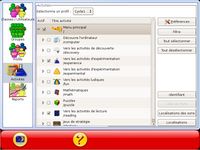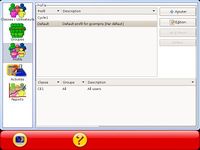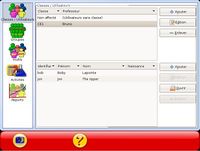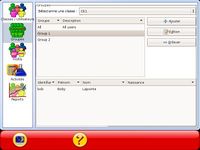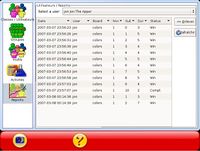Manual
Contents
Introduction
GCompris is a complete a Free educational software which contains a wide range of activities. It proposes a set of various activities aimed to cover several fields such as the functioning of the computer - mouse, keyboard...-, general learnings - reading, writing, foreign languages, algebra - as well as various activities such as memory and logic games, scientific experiments...
Today, you can find many softwares which propose individually parts of GCompris activities. Unfortunately, it is difficult to follow and maintain them and each one offers different graphic interfaces of more or less good quality. The purpose of GCompris is to provide with a development platform for educational activities. GCompris is part of GNU project and is placed under GPL license.
Minimal configuration
- Processor : Pentium 2 166Mhz
- Read only memory (RAM) : 32 Mega Bytes
- Operating system : GNU/Linux, BSD, MacOSX, Windows
- Video : A 3D card is NOT required.
Installation
The software is delivered under several forms. Follow the process according to your case.
- GNU/Linux : Use the packages delivered by GNU/Linux. If GCompris is not packaged in your Linux distribution, please contact them to ask for the inclusion of GCompris in your Linux distribution.
- Windows : Delivered under a classic installer for Windows. Windows version is limited to a number of activities, you can contribute to GCompris development and obtain the activation code for a fee.
- MacOSX : Porting in progress.
Installation from the source
Using a live CDROM
The user interface
Tous les contrôles sont conçus pour être simples d'utilisation pour les plus jeunes. GCompris est contrôlé avec une souris, il ne peut pas être utilisé sans souris ou système de pointage. All the interface is designed to be easy to use for a small children. GCompris is controlled with a mouse, it cannot be used without a mouse or a pointing system.
Main window
Kiosk mode
Language learning
Administering GCompris
Activity selection
Profile creation
Using a profile
Activity configuration
User and class creation
Groups creation
Reporting
Identification
Deployment
If you administer a school network, you can over load the configuration options of your users by yours. To edit a configuration file, the easiest way is to create one from GCompris. Simply configure GCompris as you wish, quit it and copy the created configuration file in the system one. From it, you can remove the options you don't want to be compulsory.
Configuration file example:
music=1
fx=1
screensize=1
fullscreen=1
timer=1
key="default"
GNU/Linux
On GNU/Linux, the configuration file is in the user directory under ~/.config/gcompris/gcompris.conf
You must copy your own system configuration file under /etc/gcompris.conf
Windows
On Windows, the configuration file is in C:\Documents and Settings\YOUR USER\.config\gcompris\gcompris.conf
You must put the system configuration file at the GCompris's root installation directory. By default, it's C:\Program Files\Gcompris
On Windows, it makes sense to put at least the line 'key="your 6 digit key"'. This way, all users on this PC won't have to activate GCompris.
On school networks, you can simply copy this file using your deployment system.
Portable GCompris
Portable software is a class of software that is suitable for use on portable drives such as a USB (thumb) drive or iPod, although any external hard drive could theoretically be used. The concept of carrying one's favored applications, utilities, and files on a portable drive for use on any computer is one which has evolved considerably in recent years.
GCompris can be made portable very easily by installing it on the target thumb drive and adding in its directory a gcompris.conf configuration file which includes a local user and configuration directory. The directory are specified as relative to the gcompris.exe binary.
Configuration file example:
user_dir="../My GCompris"
config_dir="../GCompris_config"
key="your 6 digit key if you have it"
Useful options
Running GCompris from a console with the --help option will display all the parameters it accepts:
- -f, --fullscreen run gcompris in fullscreen mode.
- -w, --window run gcompris in window mode.
- -s, --sound run gcompris with sound enabled.
- -m, --mute run gcompris without sound.
- -c, --cursor run gcompris with the default gnome cursor.
- -d, --difficulty display only activities with this difficulty level.
- -D, --debug display debug informations on the console.
- -v, --version Print the version of gcompris
- -x, --noxf86vm Disable XF86VidMode (No screen resolution change).
- -l, --root-menu Run gcompris with local menu (e.g -l /reading will let you play only activities in the reading directory, -l /strategy/connect4 only the connect4 activity)
- -L, --local-activity Run GCompris with local activity directory added to menu
- -a, --administration Run GCompris in administration and user-management mode
- -b, --database Use alternate database for profiles [$HOME/.config/gcompris/gcompris_sqlite.db]
- -j, --logs Use alternate database for logs
- --create-db Create the alternate database for profiles
- --reread-menu Re-read XML Menus and store them in the database
- -p, --profile Set the profile to use. Use 'gcompris -a' to create profiles
- --profile-list List all available profiles. Use 'gcompris -a' to create profiles
- --config-dir Config directory location: [$HOME/.config/gcompris]. Alternate is to set $XDG_CONFIG_HOME.
- --user-dir The location of user directories: [$HOME/My GCompris]
- --experimental Run the experimental activities
- --disable-quit Disable the quit button
- --disable-config Disable the config button
- --display-resource Display the resources on stdout based on the selected activities
- --server GCompris will get images, sounds and activity data from this server if not found locally.
- --web-only Only when --server is provided, disable check for local resource first. Data are always taken from the web server.
- --cache-dir In server mode, specify the cache directory used to avoid useless downloads.
- -g, --drag-mode Global drag and drop mode: normal, 2clicks, both. Default mode is normal.
- --nobackimg Do not display the background images of activities.

